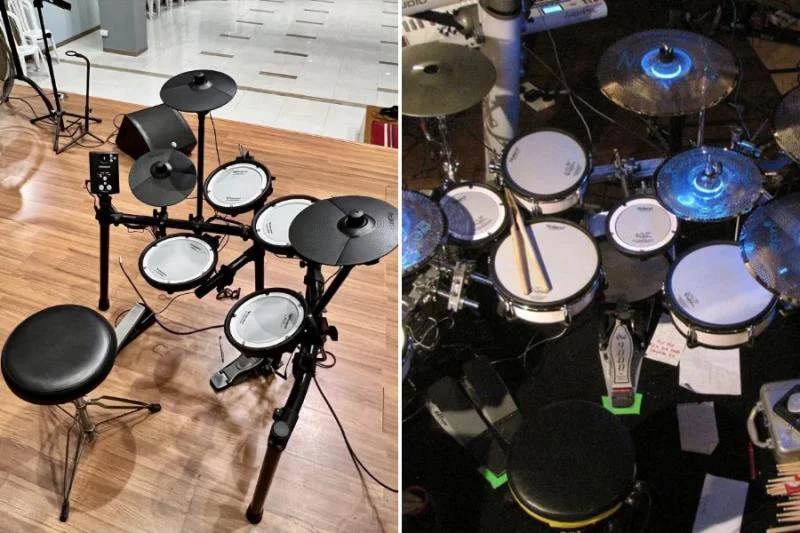Electric drums generate sound using electronic signals, while acoustic drums create sound through physical vibration. Electric drums are quieter and more portable, but they may feel different to play and can be more expensive. Acoustic drums offer an organic sound and feel but can be very loud and require soundproofing.
What are Electric Drums?
Electric drums, also known as electronic drums, are percussion instruments that use electronic signals to produce sound. Unlike acoustic drums, which create sound when struck by a drumstick or other object, electric drums use sensors or pads that are hit to trigger an electronic signal, which is then processed and amplified to produce sound.
Electric drums typically consist of a set of drum pads, a sound module or drum brain that processes the electronic signals, and a set of cymbal pads. The drum pads are usually made of rubber or mesh and are designed to simulate the feel and response of an acoustic drumhead.
Electric drums offer several advantages over acoustic drums, including the ability to control volume levels, adjust sound parameters, and play with headphones for quiet practice. They are also more compact and more accessible to transport than acoustic drums, making them popular for gigging drummers and musicians who need to travel frequently.
What are Acoustic Drums?
Acoustic drums and cymbals are played with sticks, brushes, or other percussion tools. Metal cymbals are struck or smashed with drumsticks. Wood or metal drums have animal skin or synthetic drumheads.
Drumsticks, brushes, and mallets are used to play acoustic drums. The type of drum and cymbal, drumhead material and tension, how it is struck, and room acoustics affect the sound of an acoustic drum.
Acoustic drums require more force to play than electric drums. They’re also loud, making some environments unsuitable for practice. Acoustic drums are still used in rock, jazz, and orchestral music because many drummers prefer their sound and feel.
Electric or acoustic drums depend on music, playing environment, and personal preference. Drummers play both types of drums depending on the situation.
Difference Between Electric Drums and Acoustic Drums
Electric and acoustic drums differ in several ways, including sound, volume, and portability.
Sound
Electric drums generate an electronic signal that is processed and amplified. Acoustic drums produce natural, dynamic sound by vibrating the drumhead and air in the drum shell.
Volume
Electric drums can be played quietly, making them suitable for apartments or other noise-sensitive practices. Acoustic drums are loud and need soundproofing to avoid disturbing neighbours or other musicians.
Portability
Electric drums are lighter and easier to transport and set up for gigs and rehearsals than acoustic drums.
Due to the drum pads’ response and rebound, electric drums feel different from acoustic drums. However, electric drums are often designed to mimic acoustic drums. Electronic components and sound modules make electric drum sets more expensive than acoustic ones.
Personal preference and musician needs determine the choice between electric and acoustic drums. Some drummers prefer acoustic drums’ organic sound and feel, while others prefer electric drums’ versatility and portability.







